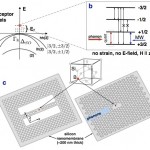Preprints
September 20th, 2012 | by
admin | published in
All, News, Preprints

Sound can be just as quantum as light. But our toolbox for single quanta of sound, i.e. phonons, is currently insufficient. Here we describe a new component that enables a chip-based, solid-state analogue of cavity-QED utilizing acoustic phonons instead of photons, phonitons instead of polaritons. We show how long-lived and tunable acceptor (hole) impurity states […]
June 10th, 2011 | by
admin | published in
All, News, Preprints
The progression of quantum technology relies in part on the identification and control of components, such as confined electrons or photons, from which systems of greater complexity are built. Here we describe another potentially valuable component, a composite object formed as a quantum mechanical superposition of a long-lived, localized phonon and a matter excitation: half-sound, half-matter.
October 12th, 2007 | by
admin | published in
All, Preprints, Research, Technology and Society
New technologies based on the exploitation of so-called “second order” quantum phenomena – such as quantum entanglement – deserve a public-friendly, rational, and sexy name. Spookytechnology is that unifying term. From historical and motivational perspectives, this name has greater value than the many variations of quantum this and quantum that presently used. As many already believe, the pursuit of spookytechnology has profound implications for the development of the physical and information sciences and ultimately for society at large. Spookytechnology will find its place in the increasingly dense line of major technological revolutions of our time: quantum, info, bio, nano, spooky.
December 23rd, 2006 | by
admin | published in
All, Essays, Preprints, Technology and Society
Nanotechnology as a social concept and investment focal point has drawn much attention. Here we consider the place of nanotechnology in the second great technological revolution of mankind that began some 200 years ago. The so-called nanotechnology revolution represents both a continuation of prior science and technology trends and a re-awakening to the benefits of significant investment in fundamental research. We consider the role the military might play in the development of nanotechnology innovations, nanotechnology’s context in the history of technology, and the global competition to lead the next technological revolution.
December 9th, 2006 | by
admin | published in
All, Essays, Preprints, Technology and Society
Manufacturing materials and systems with components thousands of times smaller than the width of a human hair promises vast and sometimes unimaginable advances in technology. Yet the term nanotechnology has formed as much from people’s expectations as from scientific reality. Understanding the creation and context of this social construction can help us appreciate and guide what may be a burgeoning revolution. This chapter considers what different groups are referring to when they say nanotechnology, how this relates to the science involved, and how the various definitions of this broad field of endeavor might be improved. The ramifications and implications of these seemingly innocuous naming choices are also discussed. Although in many respects nanotechnology serves as cover justification for increased spending in the physical sciences, at present it is the most hopeful route to solving some of the planet’s greatest problems.
August 15th, 2005 | by
admin | published in
All, Papers, Preprints
Thesis, 2005, University of Wisconsin-Madison
Semiconductor architectures hold promise for quantum information processing (QIP) applications due to their large industrial base and perceived scalability potential. Electron spins in silicon in particular may be an excellent architecture for QIP and also for spin electronics (spintronics) applications. While the charge of an electron is easily manipulated by charged gates, the spin degree of freedom is well isolated from charge fluctuations. Inherently small spin-orbit coupling and the existence of a spin-zero Si isotope facilitate long single spin qubit coherence times. Here we consider the relaxation properties of localized electronic states in silicon due to donors, quantum wells, and quantum dots, including effects due to phonons and Rashba spin-orbit coupling. Our analysis is impeded by the complicated, many-valley band structure of silicon and previously unaddressed physics in silicon quantum wells. We find that electron spins in silicon and especially strained silicon have excellent decoherence properties. Where possible we compare with experiment to test our theories. We go beyond issues of coherence in a quantum computer to problems of control and measurement. Precisely what makes spin relaxation so long in semiconductor architectures makes spin measurement so difficult. To address this, we propose a new scheme for spin readout which has the added benefit of automatic spin initialization, a vital component of quantum computing and quantum error correction. Our results represent important practical milestones on the way to the design and construction of a silicon-based quantum computer.
July 8th, 2005 | by
admin | published in
All, Nanotechnology, Papers, Preprints, Technology and Society
Am. J. Phys. 74, 4 (April 2006)
Nanotechnology has emerged as a broad, exciting, yet ill-defined field of scientific research and technological innovation. There are important questions about the technology’s potential economic, social, and environmental implications. We discuss an undergraduate course on nanoscience and nanotechnology for students from a wide range of disciplines, including the natural and social sciences, the humanities, and engineering. The course explores these questions and the broader place of technology in contemporary societies. The course is built around active learning methods and seeks to develop the students’ critical thinking skills, written and verbal communication abilities, and general knowledge of nanoscience and nanoengineering concepts. Continuous assessment was used to gain information about the effectiveness of class discussions and enhancement of student understanding of the interaction between nanotechnology and society.
